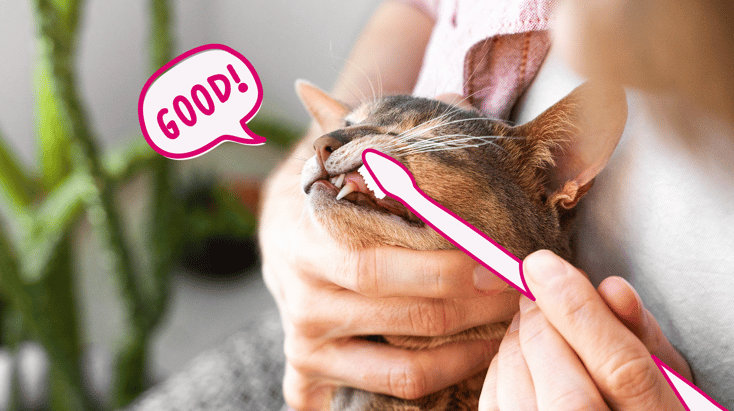Cat Dental Care: Keeping Your Cat's Teeth Clean

Table of Contents
Every time your feline friend graces you with a contented purr, have you ever paused to think about the health of those pearly whites behind their whiskered grin?
Just like us, our cats need dedicated dental care to keep their smiles bright and their overall health in check.
Key Takeaways:
- Regular dental care for cats, including check-ups and brushing, is crucial to prevent common oral health issues.
- Early detection of dental problems, from periodontal disease to oral tumors, ensures timely intervention and better health outcomes.
- Using vet-approved dental tools, like cat-specific toothbrushes and toothpaste, enhances the effectiveness of your cat's oral care routine.
Dive into our comprehensive guide on cat dental care, where we unravel the mysteries of feline oral health, from common dental issues to effective toothbrushing methods.
Let's get started.
Do Cats Need Dental Cleanings?
Absolutely, cats do benefit from dental cleanings. Just like in humans, dental health is a crucial aspect of a cat's overall well-being. Over time, plaque and tartar can build up on a cat's teeth, leading to gum disease, tooth decay, and other dental issues.
Regular dental cleanings, performed by a veterinarian, can prevent these problems and ensure your feline friend maintains a healthy mouth. Additionally, during these cleanings, vets can identify and address potential dental issues before they become more severe.
How Often Should Cats Have a Dental Cleaning?
Depending on the cat's dental health, professional cleaning may be recommended every 1-2 years. Cats prone to dental issues or with a history of dental disease might require more frequent cleanings.
Pet Dental Health Quiz
1. How often do you brush your pet’s teeth at home?
2. What color are your pet’s teeth?
3. When you look at your pet’s gums, which best describes what you see?
4. When you check your pet’s teeth, what do you see?
5. How does your pet respond to having their teeth or mouth touched?
6. When my pet eats, they:
7. When you kiss your pet you notice…
View Results
Importance of Cat Dental Health
Keeping your cat's teeth and gums healthy is crucial for their overall well-being.
Proper dental care in cats:
- Prevents pain, making eating easier.
- Reduces the risk of bacteria entering the bloodstream, which can affect vital organs.
- Avoids bad breath and tooth loss.
- Minimizes the chance of abscesses.
- Ensures a happier, more comfortable life for your cat.
Prioritizing dental health today can prevent severe health complications for your feline in the future.
Identifiers of Healthy Cat Teeth
In order to tell if your cat needs dental care, we need to know what the expectations of a healthy set of cat teeth look like.
Here are some identifiers of healthy cat teeth:
- Clean, White Teeth: Healthy cat teeth should be predominantly white, without excessive yellowing or discoloration.
- Pink Gums: The gums should be a consistent pink color. Red or white patches, or swollen gums, can be signs of issues.
- No Bad Breath: While cat breath won't smell minty fresh, it shouldn't be overly foul-smelling. Persistent bad breath can indicate dental or gastrointestinal problems.
- Absence of Tartar and Plaque: Healthy teeth won't have significant brownish tartar buildup or visible plaque.
- No Broken or Missing Teeth: Healthy dental structures mean teeth are intact without noticeable cracks, chips, or missing elements.
- Comfort While Eating: A cat with healthy teeth will eat comfortably without showing signs of pain or discomfort.
- Absence of Drooling: Excessive drooling can be a sign of dental issues or oral pain.
Regularly checking your cat's mouth and being aware of these identifiers can help ensure that any dental issues are caught and addressed early, promoting long-term dental health for your feline friend.
Keep reading: 11 Signs Your Pet Needs to See a Veterinarian
How Often Should You Brush Your Cat’s Teeth?
For optimal dental health, it's recommended to brush your cat's teeth daily. Regular brushing helps prevent the buildup of plaque and tartar, which can lead to gum disease and other dental issues. If daily brushing isn't feasible due to your cat's temperament or your schedule, aim for at least 2-3 times a week.
How to Brush Your Cat’s Teeth Effectively
Brushing your cat's teeth might seem like a daunting task, but with the right approach and tools, it can become a seamless part of your pet care routine.
Here are some steps to effectively brush your cat’s teeth at home:
1. Choose the Right Tools
Opt for a cat-specific toothbrush with soft bristles. Finger brushes can also be a good choice for some felines. When it comes to toothpaste, always select one made specifically for cats, often available in flavors like poultry or fish. Human toothpaste can be harmful to cats, so it's essential to avoid it.
2. Start Slowly
Before diving into brushing, let your cat get a taste of the toothpaste. This familiarization can make them more receptive. Additionally, allow them to sniff and investigate the toothbrush, building their comfort level with the new tool.
3. Pick a Calm Time
Timing is crucial. Choose a moment when your cat is naturally relaxed, perhaps post-playtime or after a meal. A quiet, distraction-free environment will make the process smoother for both of you.
4. Position Your Cat
Hold your feline friend securely in your lap or place them on a non-slip surface. It's best to approach from the side rather than head-on, making the experience less intimidating for your cat.
5. Brushing Technique
Begin with the front teeth, using a gentle circular motion, and progressively move to the back teeth. The gum line is a hotspot for plaque, so pay special attention there. While it's ideal to brush both the inner and outer surfaces, focusing on the outer is fine since that's where most tartar accumulates.
6. Duration
Aim to brush for about 30 seconds on each side of your cat's mouth. If at any point they seem stressed or agitated, it's okay to pause and continue later.
7. Reward and Praise
Positive reinforcement goes a long way. After each session, offer some form of reward, whether it's praise, a treat, or a bit of playtime. This can make future brushing sessions something your cat might even look forward to.
8. Consistency is Key
Establishing a routine is beneficial. Aim to brush at the same time and in the same place, creating a sense of familiarity and routine for your cat.
9. Monitor Dental Health
Regularly inspect your cat's teeth and gums. Look out for signs like redness, swelling, or unusually bad breath. If anything seems off, it's a good idea to consult with your veterinarian.
With these steps, you'll be well on your way to ensuring your cat maintains optimal dental health.
Common Dental Problems in Cats
Proper dental care for cats is just as important as for humans. By not brushing your cat’s teeth regularly or scheduling a dental cleaning appointment, they can fall prey to some problematic tooth and gum concerns.
The most common dental problems that affect cats are:
- Periodontal Disease: This is one of the most common dental issues in cats. It involves inflammation and infection of the tissues surrounding the tooth. Over time, plaque and tartar buildup can lead to gum recession, tooth loss, and even bone loss.
- Gingivitis: This refers to the inflammation of the gums. It's often the first stage of periodontal disease. If left untreated, it can progress and lead to more severe dental problems.
- Tooth Resorption: Also known as feline odontoclastic resorptive lesions (FORLs), this condition involves the erosion of a tooth, starting at the enamel and progressing to the inner layers. It's a painful condition, and the exact cause is still not entirely understood.
- Stomatitis: This is a severe and painful inflammation of the mouth's soft tissues, including the gums, cheeks, and throat. The exact cause is often unknown, but it's believed to be an immune system response to plaque or other factors.
- Tooth Fractures: Cats can break their teeth, especially the long canine teeth, due to trauma or chewing on hard objects. Broken teeth can expose the sensitive inner pulp, leading to pain and infection.
- Oral Tumors: While less common than other dental issues, cats can develop growths or tumors in their mouths. These can be benign or malignant, so any unusual lump or bump in a cat's mouth should be checked by a veterinarian.
- Bad Breath (Halitosis): While not a disease in itself, persistent bad breath can be a sign of underlying dental or gastrointestinal issues.
Keep reading: Common Diseases in Cats
Regular dental check-ups and a proactive approach to oral care can help catch and address these issues early, ensuring your feline friend maintains a healthy mouth throughout their life.
Summing Up Cat Dental Care
Maintaining the dental health of your feline companion goes beyond just a bright smile. Healthy teeth and gums are vital for a cat's overall well-being. Unaddressed dental issues can lead to pain, making it difficult for cats to eat.
Moreover, bacteria from dental diseases can enter the bloodstream, potentially affecting vital organs like the heart, liver, and kidneys. Regular dental care prevents bad breath, tooth loss, and the risk of abscesses.
By prioritizing your cat's dental health, you're not only ensuring their comfort but also reducing the risk of more severe health complications down the line. Remember, a proactive approach to dental care can lead to a happier, healthier life for your feline friend.






